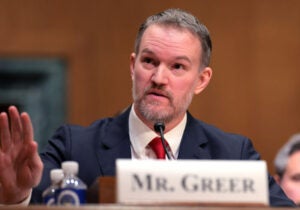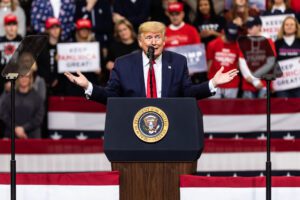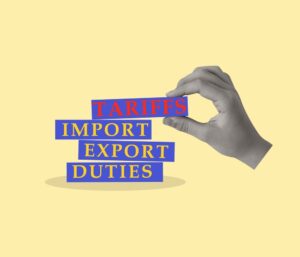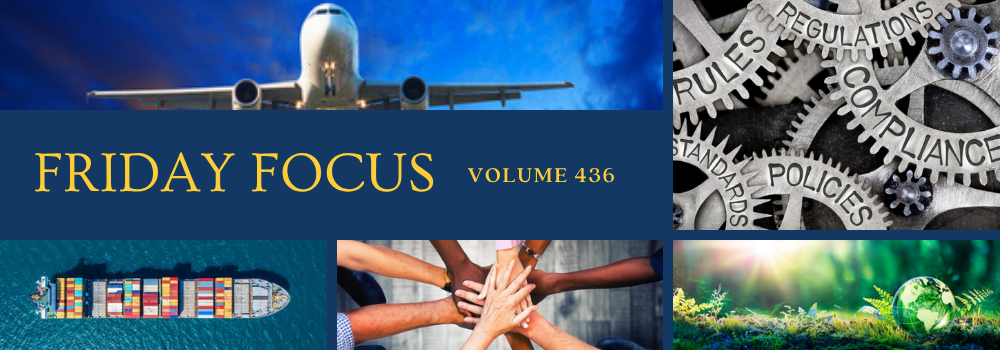WITA’s Friday Exchange Podcast:
Former Trade Negotiators Unpack this Week’s Trade & Tariff Announcements
Former trade negotiators discuss tariff and trade developments with China.
No one understands the dynamics with key U.S. trading partners better than the people who led these kind of difficult trade negotiations for the United States. WITA’s Friday Exchange brings you in the room with former trade negotiators and trade leaders to update our subscribers on the latest tariff and trade news; what remains undone; and what are expected next steps in these negotiations.
Featured Speakers:
Introduction: Kenneth Levinson, CEO, Washington International Trade Association
Jeff Moon, President, China Moon Strategies; former Assistant U.S. Trade Representative for China
Chris Padilla, Senior Advisor, Brunswick Group; former Under Secretary of Commerce for International Trade, U.S. Department of Commerce
Stephen Vaughn, Partner, King & Spalding; former General Counsel, Office of the United States Trade Representative
Moderator: Wendy Cutler, Senior Vice President, Asia Society Policy Institute; former Acting Deputy U.S. Trade Representative, Office of the U.S. Trade Representative
Watch the Video on YouTube | Listen on Spotify or Apple Podcasts
Recorded at 6:30 PM ET on 08/7/2025 | WITA
China Slashes Coal Imports As Economy Readies For Tariffs

For years, as the rest of the world turned away from coal, China had been boosting imports to power its booming electrification, and a vibrant new industry of electric vehicles and batteries. In 2024, it imported 352.2 million metric tons of coal, up 79% from 197 million in 2019.
This year, China is finally giving up the rock. In July, its purchases of coal dropped 22.9% year-on-year by volume to 35.6 million tons, while boosting imports of other energy sources. Imports of natural gas rose 82.4% to 10.6 million tons, and imports of crude petroleum oil increased 11.5% to 47.2 million tons.
China diminished imports from its top sources: Russia, Australia, Mongolia and Indonesia. The only country it increased coal imports from was Canada, boosting imports 13.3% to 5.4 million tons.
So what is going on? China has been producing more coal domestically and also developing more alternative energy sources such as wind and solar. It’s also transforming its economy to become less dependent on global trade, by ramping up production in assets like coal, where it has abundant resources. Exports of fertilizers rose 134.5% to $2.1 billion, and exports of agricultural products increased 1.6% to $8.4 billion.
Adjusting to U.S. Tariffs
The switch is just one of the ways China has been adjusting to duties from its biggest export market. How the world adapts to a newly protectionist U.S. is one of the most important economic stories of the decade. On Thursday, August, 7, Washington slapped duties from 10% to 41% on hundreds of billions worth of imports from dozens of countries…
Current U.S. tariffs on Chinese imports vary, but are generally around 45%. The U.S. has also eliminated the de minimis exemption, which allowed companies to ship goods worth under $800 into the U.S. tariff free.
Negotiators from Washington and Beijing are currently negotiating a new agreement governing tariffs between the two countries. The two sides have set an August 12 deadline, after which they’ve threatened to impose duties of over 100%, which would cripple trade between the world’s dominant trading economies.
08/07/2025 | John Miller | Trade Data Monitor
Ambassador Jamieson Greer Remarks at the Reindustrialize Summit in Detroit, Michigan

WITA Editor’s Note: Following is an excerpt from a speech made by Jamieson Greer, the United States Trade Representative, on July 16. Ambassador Greer also recently published a guest essay in the New York Times that can be found here.
What we want is an industrial economy built around productivity rather than exploitation. In that way, we create a positive feedback loop that rewards workers, business, and the nation at large. Innovation drives productivity, which raises wages—in a virtuous cycle underpinned by manufacturing. Who wouldn’t want the United States to have that? I’ll tell you. Our adversaries and the people making money supplying foreign manufacturing at the expense of U.S. workers.
Our industrial base wasn’t lost overnight, and restoring it won’t be easy either. But failure to do so is not an option. This is why—mindful of manufacturing’s unique benefits—President Trump declared a national emergency with respect to the trade deficit and the implications it has for our industrial base.
The result has been a 10% global tariff on all countries, higher reciprocal tariffs on the most distorted trade relationships, and cumulative tariffs of over 55% percent on China. Indeed, over the last few days, the President has sent letters to various countries indicating tariffs could go even higher to correct for the lack of reciprocity in our trade relations that leads to our global trade deficit. He has also signaled a willingness to negotiate new terms of trade for countries willing to participate constructively in our reindustrialization.
In every letter President Trump includes a line, which underscores the purpose of his tariff program: “there will be no tariff if [you] decide to build or manufacture product within the United States.”
The President has complemented his reciprocal tariff program with proposed tariffs in a number of strategic sectors where America must reestablish secure supply chains. Using these tools, the Administration has tightened steel and aluminum tariffs, imposed new measures on autos and auto parts not made in the United States, and launched several investigations into the national security threats associated with reliance on foreign semiconductors, pharmaceuticals, drones, and critical minerals.
I know these policies will succeed in fostering our reindustrialization. Don’t take my word for it, the data show that this approach works.
As far back as 1791, when Alexander Hamilton published his Report on Manufactures, the United States has used tariffs to protect, and grow, our domestic industry. Henry Clay’s American System took things to new heights—by 1901, just the increase in U.S. steel production in the prior six years was larger the amount of steel produced by the entire world in any year before 1890.
Much more recently, President Reagan used import restraints to address a surge of Japanese auto imports that threatened to destroy the American auto sector in the early 1980s. Within a decade of imposing import quotas, he triggered a wave of greenfield investment. By the 1990s, Japanese carmakers created more than 100,000 new American jobs at more than 300 new production facilities. Today, Honda and Toyota have among the highest domestic content for cars sold in America. It is no exaggeration to say that the American auto industry is alive today because of President Reagan’s pragmatic trade restrictions.
But the intervening decades saw a trade policy that incentivized offshoring and outsourcing. With both hubris and naiveté, policymakers believed they could do economic “nation building” by pushing economic integration with non-market economies like China and Vietnam. In reality, this undermined our manufacturing base. By 2016, the American people had had enough.
President Trump was elected in part on his promise to reject economic policies that undermined American competitiveness.
07/16/2025 | Ambassador Jamieson Greer | Office of the U.S. Trade Representative
Trump, Tariffs & Trade Wars

Since Donald Trump’s first term as the 45th President of the United States, his approach to trade — aggressive tariffs, protectionist rhetoric, and coercive deal-making — has sparked debate. In his second term, the question arises: Does Trump’s trade policy reflect established economic trade theories, or is it driven by instinct, political strategy, or a revival of outdated doctrines?
To answer this, we must examine his policies through the lens of trade theories (classical and modern), mercantilism, comparative advantage, and free trade principles and assess whether his actions align with or diverge from these frameworks.
Trump’s trade policies, both in his first term (2017–2021) and his second term, show similarities to mercantilism, an economic theory prominent in the seventeenth and eighteenth centuries. Mercantilism views trade as a zero-sum game, where a nation’s wealth is maximised by increasing exports and minimising imports, aiming to achieve a positive trade balance. Trump’s coercive tariff strategies reflect this mindset; they aim to reduce trade deficits by imposing high tariffs, discouraging imports, and protecting domestic industries.
During his first term, Trump imposed tariffs on solar panels and washing machines (30–50 per cent). Later, he imposed tariffs on steel (25 per cent) and aluminium (10 per cent) on most countries, and extended them even to allies like the European Union, Canada, and Mexico.
In his second term, Trump escalated this approach with a baseline 10 per cent tariff on most imports; country-specific tariffs range up to 50 per cent; on Chinese goods, he announced a staggering 145 per cent cumulative tariff. These measures align with mercantilist goals of reducing imports and boosting domestic production, as Trump has repeatedly argued that trade deficits—$1.2 trillion in goods in 2024—represent a net loss for the U.S. economy.
Trump’s brash rhetoric underscores this mercantilist bent. He claimed that countries like China, Japan, and others have been “ripping off” the U.S. through unfair trade practices. His focus on bilateral trade deficits as a measure of economic success, evident in his criticism of China’s $295.4 billion trade surplus with the U.S. in 2024, echoes mercantilist principles that prioritise surpluses over mutual gains.
However, modern economists argue that trade is not a zero-sum game and that bilateral deficits do not inherently indicate economic weakness. This suggests Trump’s approach may be misaligned with contemporary trade theory.
08/04/2025 | Chakradhar Jadhav | Madras Courier
Taxation Without Representation: How Trump’s Tariff Policy Undermines Democracy And International Legal Norms

What started as a trade war in 2018 – and a domestic policy aimed at recalibrating the U.S. trade policy – has quietly transformed into a tool of hidden taxation, enabling the U.S. executive branch, meaning the President of the United States, to raise revenue and dramatically influence fiscal policy without legislative consent or even minimal participation in the legislative process by Congress. This divergence from legal norms represents a constitutional rupture – what I call the rise of a shadow fiscal state: a parallel tax system designed and executed solely through executive discretion rather than transparency and congressional legislation.
The fiscal logic behind tariff expansion
The United States is in debt and needs revenue. The Republican Party controls Congress and in theory can pass any legislation it wishes. However, the Party is generally more known for favoring populistic tax breaks, not tax hikes. For decades we tried trickle-down economics, but it failed as research shows.
Yet, tariffs can raise revenue. And for historical reasons, years ago Congress delegated the authority to introduce tariffs to the executive branch. On top of that, the judicial branch, respecting the autonomy of the executive branch, has been very reluctant to interfere in the way this authority is being used, since it was always justified by “national security” reasoning. This turned a narrow and specific delegated trade authority into a ripe opportunity for a power-hungry executive branch to reshaping the U.S. federal tax system without Congress’ involvement.
Legal framework and executive overreach
U.S. federal trade states, such as Section 301 of the Trade Act of 1974 and Section 232 of the Trade Expansion Act of 1962, authorize the President of the United States to introduce tariffs when he or she determines that the United States’ trade rights are being denied or certain national security threats rise. However, none of these statues intend tariffs to be turned into a fiscal tool for domestic debt management. Therefore, using those provisions for this goal reflects a significant abuse of power.
It also raises major constitutional concerns. Under Article I of the U.S. Constitution, the power to tax is granted to Congress. However, when tariffs are used to generate revenue or shape the United States’ federal fiscal framework, they function effectively as a hidden federal consumption tax on the American people. Although tariffs are imposed at the border on imported goods, the economic burden of tariffs typically shifts from importers to retailers, and ultimately to domestic consumers, as each step in the supply chain passes on the added costs through higher prices. This leads to a paradox. On the one hand, Congress recently passed the One Big Beautiful Bill Act which among others, made many of the individual tax breaks of the Tax Cuts and Jobs Act of 2017 permanent. On the other hand, and at the same time this was happening, the Executive separately introduced historically high tariffs without the constitutional process that was meant to ensure congressional debate, approval and accountability.
08/04/2025 | Doron Narotzki | Verfassungsblog
WITA – We put the community in trade community.
Information about upcoming WITA and trade community events



